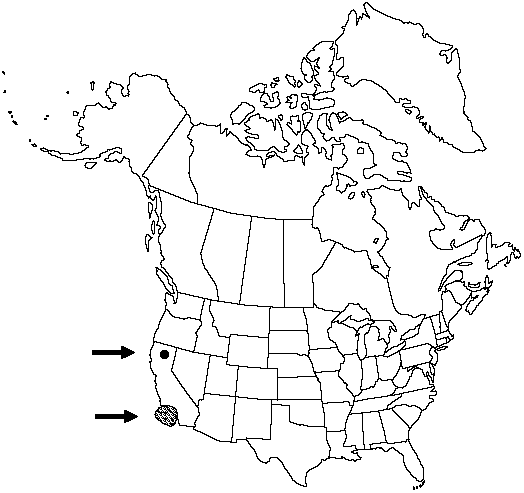Difference between revisions of "Pentagramma triangularis subsp. semipallida"
Amer. Fern J. 80: 16. 1990.
FNA>Volume Importer |
imported>Volume Importer |
||
| (7 intermediate revisions by 2 users not shown) | |||
| Line 7: | Line 7: | ||
|year=1990 | |year=1990 | ||
}} | }} | ||
| − | |basionyms={{Treatment/ID/ | + | |special_status={{Treatment/ID/Special_status |
| + | |code=E | ||
| + | |label=Endemic | ||
| + | }} | ||
| + | |basionyms={{Treatment/ID/Basionym | ||
|name=Pityrogramma triangularis var. semipallida | |name=Pityrogramma triangularis var. semipallida | ||
|authority=J. T. Howell | |authority=J. T. Howell | ||
| + | |rank=variety | ||
| + | |publication_title=Leafl. W. Bot. | ||
| + | |publication_place=9: 223. 1962 | ||
}} | }} | ||
|synonyms= | |synonyms= | ||
| Line 19: | Line 26: | ||
}}<!-- | }}<!-- | ||
| − | --><span class="statement" id="st- | + | --><span class="statement" id="st-undefined" data-properties=""><b>Petiole </b>glabrous, not viscid-glandular. <b>Blade</b> thin and herbaceous, sometimes thick (but not leathery), not viscid-glandular, abaxially densely white-farinose, adaxially glabrous. <b>Distal</b> pinnae mostly regularly lobed. <b>Proximal</b> basiscopic lobes of basal pinnae pinnatifid, often deeply so.</span><!-- |
-->{{Treatment/Body | -->{{Treatment/Body | ||
| Line 25: | Line 32: | ||
|elevation=100–900 m | |elevation=100–900 m | ||
|distribution=Calif. | |distribution=Calif. | ||
| − | |discussion=<p>Pentagramma triangularis subsp. semipallida, as here treated, remains heterogeneous. Diploid (based on spore size) populations occur in the foothills of the Sierra Nevada in Butte County, California. Tetraploids (based on spore size) of similar morphology are apparently restricted to Santa Barbara County, California, including the adjacent Channel Islands. The relationship between these two variants has not been studied in detail.</p> | + | |discussion=<p><i>Pentagramma triangularis </i>subsp.<i> semipallida</i>, as here treated, remains heterogeneous. Diploid (based on spore size) populations occur in the foothills of the Sierra <i>Nevada</i> in Butte County, California. Tetraploids (based on spore size) of similar morphology are apparently restricted to Santa Barbara County, California, including the adjacent Channel Islands. The relationship between these two variants has not been studied in detail.</p> |
|tables= | |tables= | ||
|references= | |references= | ||
| Line 34: | Line 41: | ||
-->{{#Taxon: | -->{{#Taxon: | ||
name=Pentagramma triangularis subsp. semipallida | name=Pentagramma triangularis subsp. semipallida | ||
| − | |||
|authority=(J. T. Howell) Yatskievych | |authority=(J. T. Howell) Yatskievych | ||
|rank=subspecies | |rank=subspecies | ||
| Line 47: | Line 53: | ||
|publication title=Amer. Fern J. | |publication title=Amer. Fern J. | ||
|publication year=1990 | |publication year=1990 | ||
| − | |special status= | + | |special status=Endemic |
| − | |source xml=https:// | + | |source xml=https://bitbucket.org/aafc-mbb/fna-data-curation/src/2e0870ddd59836b60bcf96646a41e87ea5a5943a/coarse_grained_fna_xml/V2/V2_291.xml |
|genus=Pentagramma | |genus=Pentagramma | ||
|species=Pentagramma triangularis | |species=Pentagramma triangularis | ||
|subspecies=Pentagramma triangularis subsp. semipallida | |subspecies=Pentagramma triangularis subsp. semipallida | ||
| − | |||
| − | |||
| − | |||
| − | |||
| − | |||
| − | |||
| − | |||
| − | |||
| − | |||
}}<!-- | }}<!-- | ||
-->[[Category:Treatment]][[Category:Pentagramma triangularis]] | -->[[Category:Treatment]][[Category:Pentagramma triangularis]] | ||
Latest revision as of 21:22, 5 November 2020
Petiole glabrous, not viscid-glandular. Blade thin and herbaceous, sometimes thick (but not leathery), not viscid-glandular, abaxially densely white-farinose, adaxially glabrous. Distal pinnae mostly regularly lobed. Proximal basiscopic lobes of basal pinnae pinnatifid, often deeply so.
Habitat: Chaparral, pine and oak woodlands
Elevation: 100–900 m
Discussion
Pentagramma triangularis subsp. semipallida, as here treated, remains heterogeneous. Diploid (based on spore size) populations occur in the foothills of the Sierra Nevada in Butte County, California. Tetraploids (based on spore size) of similar morphology are apparently restricted to Santa Barbara County, California, including the adjacent Channel Islands. The relationship between these two variants has not been studied in detail.
Selected References
None.
